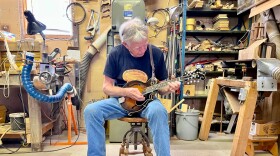A large piece of metal blazes with fire inside the Bucyrus Copper Kettle Works shop in North Central Ohio.
Flames sweep across one side and stray sparks float like fireflies, as owner James Patrick uses a long rod to twist and tilt the copper over the heat.
“That's our fuel oil forge,” he explained. “It burns at 2,000 degrees.”
The process, called annealing, makes the metal less brittle, Patrick said, so it’s easier to work with later. It’s just the beginning of the hours-long undertaking to create a copper kettle.

Patrick lifts the now blackened metal off the flame, and dunks it into a vat of blue-tinted liquid.
“So this is sulfuric acid and water,” he said. “The pH is less aggressive than what Coca-Cola is.”
When the metal comes out of this pool later, it’ll be cool, shiny and pink, ready to mold into its final shape.
A history of making copper kettles
Patrick has been making kettles like this for . He learned from people who have been doing this for decades, and they learned from coppersmiths who practiced for decades before them, to the company’s founders.
“So we have two guys, Daniel Picking and Jacob Geiger,” Patrick said. “They start a hardware store in 1863, and anytime the hardware store needed to get copper kettles, they had to go all the way to Lancaster, Pennsylvania to pick ‘em up.”
That was too far of a trek, so they built this shop at 119 South Walnut Street in Bucyrus — the same one that stands today, and trained the tinsmiths in their hardware store to work with copper.

The shop started selling apple butter kettles in 1874.
Decades later, in the 1930s, the hardware store went out of business, weakened by the Great Depression, Patrick said. But the copper kettle shop had learned to be resilient early on.
“Back in the 1880s, they had a bad year for apples, and they mainly just made apple butter kettles,” Patrick said. “So what they ended up doing was and making candy, swiss [cheese] and popcorn kettles too.”
Keeping the kettle tradition alive
To this day, there’s still a lot of demand for these products. Patrick said the waitlist for the shop’s copper kettles is a year-long.
Amish families come to get their copper kettles repaired. Appalachian communities use these kettles in their apple butter festivals. And sweet shops all over the country source their kettles from here.
“There's a lot of candy companies that say the candy doesn't taste as good in stainless [steel] as it does in copper,” Patrick said.
The shop makes copper, too, for orchestras all over the world.
“And I think we're the last ones, really, to make them by hand, as far as I know,” Patrick said.
“When you go on YouTube and look around, there's a lot of different blacksmithing processes, but type in copper works or copper apple butter kettles and see how much comes up there. There's not a whole lot. I think this is one of the last old shops in the whole country. We really need to save the process.”

He plans to do just that.
Back in the shop’s work area, he lifts the now shiny kettle he’s working on out of the tub of sulfuric acid, rinses it with water and towels it dry.
Next up: planishing, where the copper will be hammered until it’s smooth and tough. This part of the process has changed a little since the 1800s.
“In 1913, they introduced electricity to the building,” Patrick said, “and they brought this power hammer.”
He flips a switch and a rotating belt lifts and lowers a wooden hammer. In minutes, it pounds the lower half of the kettle from a misshapen bowl into a smooth, round sphere.
The rest Patrick hammers by hand.
It’s a craft he hopes to share, with plans for and welding classes, giving people a taste not just of copper products, but of the age-old processes that make them unique.






